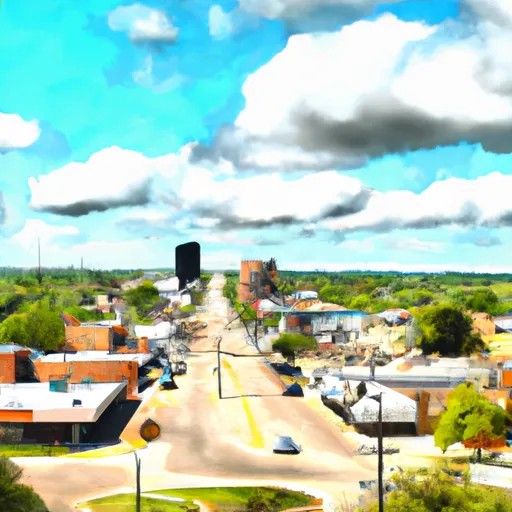-
 Snoflo Premium
Snoflo Premium
Get unlimited access to all our content
With no Ad interruptions! - Start Your Free Trial Login with existing account
Skiatook
Eden Index
Climate
8.3
•
Recreation
2.8
•
Community
2.5
•
Safeguard
4.9/10

Skiatook is a charming town located in Osage County, Oklahoma. Known for its scenic beauty and small-town atmosphere, Skiatook offers a unique blend of natural attractions and outdoor recreation opportunities.
The climate in Skiatook is characterized by hot summers and mild winters. Summers are typically hot and humid, with temperatures often surpassing 90°F (32°C), while winters are mild with temperatures ranging from 30°F (-1°C) to 50°F (10°C). The area experiences moderate rainfall throughout the year.
Hydrologically, Skiatook Lake is a prominent feature in the town. It is a reservoir created by the U.S. Army Corps of Engineers and is a popular destination for boating, fishing, and other water sports. The lake is a habitat for various fish species, including bass, catfish, and crappie, making it a favorite among fishing enthusiasts.
Aside from the lake, Skiatook offers several parks and outdoor recreation areas. Osage Park features walking trails, picnic areas, and a playground, while Tall Chief Cove offers camping facilities and hiking trails. Additionally, the nearby Osage Hills State Park is a great spot for camping, hiking, and wildlife viewing.
In summary, Skiatook, Oklahoma, enjoys a diverse climate with hot summers and mild winters. The town's hydrology is centered around the beautiful Skiatook Lake, which offers numerous outdoor recreation opportunities like fishing and boating. Additionally, Skiatook boasts several parks and nearby state parks, providing ample opportunities for outdoor enthusiasts to explore nature and enjoy various activities.
What is the Eden Index?
The Snoflo Eden Index serves as a comprehensive rating system for regions, evaluating their desirability through a holistic assessment of climate health, outdoor recreation opportunities, and natural disaster risk, acknowledging the profound impact of these factors on livability and well-being.
Climate Health Indicator (CHI): 8.3
Skiatook receives approximately
1012mm of rain per year,
with humidity levels near 81%
and air temperatures averaging around
16°C.
Skiatook has a plant hardyness factor of
7, meaning
plants and agriculture in this region tend to thrive during the non-winter months.
By considering the ideal temperature range, reliable water supplies, clean air, and stable seasonal rain or snowpacks, the Climate Health Indicator (CHI) underscores the significance of a healthy climate as the foundation for quality living.
A healthy climate is paramount for ensuring a high quality of life and livability in a region, fostering both physical well-being and environmental harmony. This can be characterized by ideal temperatures, reliable access to water supplies, clean air, and consistent seasonal rain or snowpacks.
Weather Forecast
Streamflow Conditions
Verdigris
Area Rivers
Verdigris
Snowpack Depths
Verdigris
Reservoir Storage Capacity
Verdigris
Groundwater Levels
Recreational Opportunity Index (ROI): 2.8
The Recreational Opportunity Index (ROI) recognizes the value of outdoor recreational options, such as parks, hiking trails, camping sites, and fishing spots, while acknowledging that climate plays a pivotal role in ensuring the comfort and consistency of these experiences.
Access to outdoor recreational opportunities, encompassing activities such as parks, hiking, camping, and fishing, is crucial for overall well-being, and the climate plays a pivotal role in enabling and enhancing these experiences, ensuring that individuals can engage in nature-based activities comfortably and consistently.
Camping Areas
| Campground | Campsites | Reservations | Toilets | Showers | Elevation |
|---|---|---|---|---|---|
| Fall River State Park | 165 | 995 ft | |||
| Wah - Sha - She State Park | None | 771 ft | |||
| Washington Cove - Copan Lake | None | 745 ft | |||
| Johnstone Park | 6 | 670 ft | |||
| Sedan City Park | 15 | 843 ft | |||
| Caney Bend | 5 | 800 ft | |||
| Osage Hills State Park | None | 785 ft | |||
| Post Oak Park - Copan Lake | None | 749 ft | |||
| Murphys Meadow Military - McAlester | None | 725 ft | |||
| Card Creek - Elk City Lake | None | 815 ft |
Catastrophe Safeguard Index (CSI):
The Catastrophe Safeguard Index (CSI) recognizes that natural disaster risk, encompassing floods, fires, hurricanes, and tornadoes, can drastically affect safety and the overall appeal of an area.
The level of natural disaster risk in a region significantly affects safety and the overall livability, with climate change amplifying these risks by potentially increasing the frequency and intensity of events like floods, fires, hurricanes, and tornadoes, thereby posing substantial challenges to community resilience and well-being.
Community Resilience Indicator (CRI): 2.5
The Community Resilience Indicator (CRI) recognizes that education, healthcare, and socioeconomics are crucial to the well-being of a region. The CRI acknowledges the profound impact of these elements on residents' overall quality of life. By evaluating educational resources, healthcare accessibility, and economic inclusivity, the index captures the essential aspects that contribute to a thriving community, fostering resident satisfaction, equity, and social cohesion.

